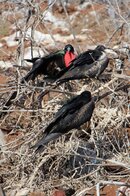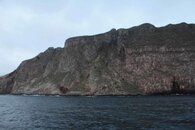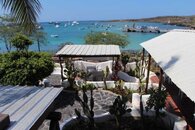drrich2
Contributor
-----On the sun deck was a refrigerator with varied beverages including Coca-Cola, but I saw no Diet Coke or Coke Zero. Coffee and hot water were in the salon; I saw people using tea bags to make tea. There was alcohol for after diving – including wine (I don’t drink, so no details). Food was generally good and plentiful; at times there were 3 different ‘salad-type’ offerings, 2 meats and some cold cuts and cheese, and more. There was generally desert after lunch and dinner.
-----My stateroom was well-maintained with a decent amount of storage. Bed comfortable. My bathroom was fairly spacious by live-aboard standards. Shower water could be quite hot and air conditioning was capable.
-----These people do Explorer Ventures proud. The guides, Jorge (‘Hore-Hey’) and Daniel were good guides, genuinely affable and helpful, provided educational presentations and helped out with other boat tasks. They alternated between our 2 groups daily. Rooms were kept clean and tended. Food was good; earlier in the week I thought it wasn’t up there with some Aggressor boats I’ve been on, but by week’s end the cook won me over pretty well. Not great, but good. After dives we were often offered hot drinks in cups (e.g.: hot chocolate, tea, strawberry or some white creamy stuff). I think the guides do 2 weeks on and 2 off, so they seem fresh (these 2 did the guiding; guiding didn’t rotate through several boat crew like I’ve seen on one boat elsewhere).
-----A word about English: my impression of Ecuador and the Galapagos (Spanish is the main language) is that ‘passable English’ is widely spoken, often not quite to the fluency I found in Bonaire or Cozumel, and it’s fine for getting by routinely but where detailed info. matters you may have a little awkwardness. Saw more of this at the Guayaquil Airport; the boat crew were pretty good with English, some rough edges but nothing that couldn’t be worked around.




-----I only speak English. My hassles were communicating with a shuttle driver, some Guayaquil Airport staff (mistakenly ended up in domestic departure lounge and needed to get to international) and the counter lady at an airport Kentucky Fried Chicken. You don’t need to fear going to Ecuador if you only speak English.


Perspective matters. I’m an older (50), not very fit, fat guy, a mediocre intermediate diver with fair gas consumption, an introvert who’s not good at situational awareness and doesn’t multi-task well so when I try to address one task (e.g.: take the picture) it’s easy to lose track of something else (e.g.: that’s why I accidentally dipped down to 105 feet deep that last dive). Went into this with around 430 dives, mostly Caribbean and Florida, some North Carolina and California Channel Islands. I’m not self-deprecating; you need to know this when deciding how tough/demanding the diving is likely to be for you.
-----A young, fit diver with some natural athleticism can compensate a little for mediocre skill. An older, beefier diver with excellent dive skill can anticipate and compensate for problems earlier so he doesn’t have to over-exert. I had to focus on keeping up with the guide’s location, found trying to get situated in rocks difficult (e.g.: letting air out of wing would let me settle better, but if the guide decides to move soon, I wanted that gas!), consciously slowing my breathing rate to stretch my gas supply added some strains (e.g.: probably CO2 headaches on some dives), and 4 dives/day were a workout!
-----Speaking of which, I went from thinking ‘Why don’t they do 5/day like Caribbean live-aboards’ to ‘Oh, crap. We’re down for 4 today! Hope I hold up.’
-----I chose this trip for 4 main reasons:
1.) Galapagos live-aboard trip total costs are around double a Caribbean trip. Needed to do it while I’m working and have the money.
2.) Galapagos diving can be strenuous. Need to do it before I get older and get physical infirmities.
3.) Getting time off from work can be tough. In Nov. 2019, I learned good coverage was lined up for January.
4.) Given the choice I like warmer water. That put me out of whale shark season and we saw none. Given the other strains, just the thought of adding a hood makes me wince.
-----This was a bucket list trip. I can’t justify spending that much family money on just me for repeats. I was very blessed to get to go and very glad I went. My life is enriched but it’s a one-shot.
-----We had 2. We boarded the boat on Monday morning. Tuesday afternoon we visited North Seymour via panga where a guide led us around, viewing arid, scruffy terrain (I was told the dead-looking little trees would vegetate in about a week and remain so through April, perhaps the 1st week of May, in accordance with rains), and variously viewed sea lions, lava lizards (small), land iguanas, blue-footed boobies, frigate birds and more. They rotate guides; this was one good.




-----My stateroom was well-maintained with a decent amount of storage. Bed comfortable. My bathroom was fairly spacious by live-aboard standards. Shower water could be quite hot and air conditioning was capable.
The Crew
-----These people do Explorer Ventures proud. The guides, Jorge (‘Hore-Hey’) and Daniel were good guides, genuinely affable and helpful, provided educational presentations and helped out with other boat tasks. They alternated between our 2 groups daily. Rooms were kept clean and tended. Food was good; earlier in the week I thought it wasn’t up there with some Aggressor boats I’ve been on, but by week’s end the cook won me over pretty well. Not great, but good. After dives we were often offered hot drinks in cups (e.g.: hot chocolate, tea, strawberry or some white creamy stuff). I think the guides do 2 weeks on and 2 off, so they seem fresh (these 2 did the guiding; guiding didn’t rotate through several boat crew like I’ve seen on one boat elsewhere).
-----A word about English: my impression of Ecuador and the Galapagos (Spanish is the main language) is that ‘passable English’ is widely spoken, often not quite to the fluency I found in Bonaire or Cozumel, and it’s fine for getting by routinely but where detailed info. matters you may have a little awkwardness. Saw more of this at the Guayaquil Airport; the boat crew were pretty good with English, some rough edges but nothing that couldn’t be worked around.
-----I only speak English. My hassles were communicating with a shuttle driver, some Guayaquil Airport staff (mistakenly ended up in domestic departure lounge and needed to get to international) and the counter lady at an airport Kentucky Fried Chicken. You don’t need to fear going to Ecuador if you only speak English.
My Fellow Divers
I believe photo taken by a crewman, and shared via DropBox from the camera's owner. I'm far rear right. Our 2 guides are in front. There were 13 guests.
In my limited experience live-aboard guests tend to be friendly, fun-loving rec. dive enthusiasts with a strong shared interest happy to be there and prone to reach out to others and help ensure everyone has a good time. This group was perhaps the strongest I’ve seen in that regard. Young (I’m 50, and only one guy looked a bit older than me), physically fit (at 6’1” and around 265-lbs. I was the main ‘fat dude’), well-traveled (I got destination envy) and interested in a range of topics (e.g.: particularly food). It was a great bunch. I’m an old out-of-shape introvert who can only take boisterous social environments so much, so I may’ve come across as a recluse with narcolepsy (love those naps!). Me
Perspective matters. I’m an older (50), not very fit, fat guy, a mediocre intermediate diver with fair gas consumption, an introvert who’s not good at situational awareness and doesn’t multi-task well so when I try to address one task (e.g.: take the picture) it’s easy to lose track of something else (e.g.: that’s why I accidentally dipped down to 105 feet deep that last dive). Went into this with around 430 dives, mostly Caribbean and Florida, some North Carolina and California Channel Islands. I’m not self-deprecating; you need to know this when deciding how tough/demanding the diving is likely to be for you.
-----A young, fit diver with some natural athleticism can compensate a little for mediocre skill. An older, beefier diver with excellent dive skill can anticipate and compensate for problems earlier so he doesn’t have to over-exert. I had to focus on keeping up with the guide’s location, found trying to get situated in rocks difficult (e.g.: letting air out of wing would let me settle better, but if the guide decides to move soon, I wanted that gas!), consciously slowing my breathing rate to stretch my gas supply added some strains (e.g.: probably CO2 headaches on some dives), and 4 dives/day were a workout!
-----Speaking of which, I went from thinking ‘Why don’t they do 5/day like Caribbean live-aboards’ to ‘Oh, crap. We’re down for 4 today! Hope I hold up.’
-----I chose this trip for 4 main reasons:
1.) Galapagos live-aboard trip total costs are around double a Caribbean trip. Needed to do it while I’m working and have the money.
2.) Galapagos diving can be strenuous. Need to do it before I get older and get physical infirmities.
3.) Getting time off from work can be tough. In Nov. 2019, I learned good coverage was lined up for January.
4.) Given the choice I like warmer water. That put me out of whale shark season and we saw none. Given the other strains, just the thought of adding a hood makes me wince.
-----This was a bucket list trip. I can’t justify spending that much family money on just me for repeats. I was very blessed to get to go and very glad I went. My life is enriched but it’s a one-shot.
Land Excursions
-----We had 2. We boarded the boat on Monday morning. Tuesday afternoon we visited North Seymour via panga where a guide led us around, viewing arid, scruffy terrain (I was told the dead-looking little trees would vegetate in about a week and remain so through April, perhaps the 1st week of May, in accordance with rains), and variously viewed sea lions, lava lizards (small), land iguanas, blue-footed boobies, frigate birds and more. They rotate guides; this was one good.






